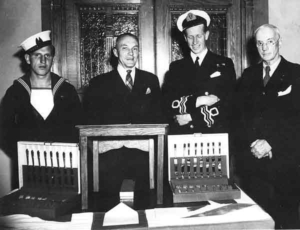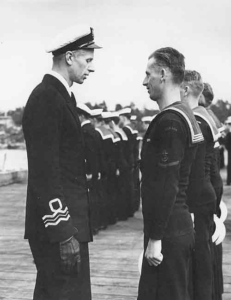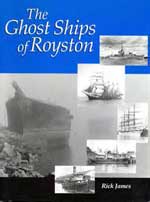Commander
A young Royal Canadian Navy lieutenant who became a hero of the Battle of the Atlantic in World War II remains relatively uncelebrated in his hometown of Victoria, BC.
The daring exploits of Edward Theodore “Ted” Simmons have gone largely unrecognized by his countrymen.
Yet like many other Canadians who sacrificed personal security for the uncertainty and danger of wartime service, Simmons displayed genuine bravery in the face of terrible – and terrifying – circumstances.
Simmons was born in Vernon, BC in 1910, eventually moving to Victoria where he attended school and later worked as a salesman for Standard Furniture. In 1939, with war in Europe looming, Simmons registered for service with the Royal Canadian Naval Volunteer Reserve (RCNVR), leaving civilian life and a promising career behind.
After completing his initial training, Acting Lieutenant Simmons was appointed in the spring of 1940 to HMCS STONE FRIGATE, a naval training facility at Kingston, Ontario. When corvette K116, HMCS CHAMBLY, was commissioned in December 1940, Simmons became its second in command. K116 soon joined a Newfoundland-based escort force assigned to accompany vessels across the North Atlantic and train other escorts.
In September 1941, a convoy of 64 merchantmen fell prey to a deadly attack by German U-boats off Greenland’s coast. Some 18 merchant ships were sunk in the running battle that followed. HMCS MOOSE JAW and HMCS CHAMBLY rushed to the convoy’s assistance. As that disastrous night of September 10th unfolded, CHAMBLY finally picked up an underwater contact and laid a pattern of depth charges that forced U-501 to the surface. After MOOSE JAW rammed the U-boat to slow its speed, CHAMBLY’s captain ordered a boat away and a boarding party led by Lt Simmons jumped aboard the U-boat despite the perilous heavy sea running. They were in search of code books or one of the elusive German cipher machines; such a prize would allow the Allies to break the secret of enemy communications.
Once the party was on the U-boat’s heaving deck, Simmons yelled “Hands up!“, seized a German crewman who spoke English and ordered him below. When his captive refused, protesting that “No good, boat alles kaput!” Simmons brandished his 45 calibre pistol and propelled two other Germans towards the conning tower. They too refused to go below; the sub was now sinking stern first and time was running out. Simmons jumped onto the ladder down the hatch with a flashlight. Descending, he discovered that the captured U-boat was flooding fast. Simmons abandoned hope of retrieving code books and scrambled back up the conning tower. He quickly ordered everyone over the side, boarding party and prisoners alike.
When the group mustered aboard CHAMBLY, it was discovered that a stoker, William Irvin Brown, was missing, possibly sucked under by the U-boat as it descended to the sea bottom. For his “bravery and enterprise” in the sinking of U-501, Lt Simmons received the Distinguished Service Cross (DSC).

Ted Simmons (2nd from right) accepts a donation of cutlery for BEACON HILL’s crew from Victoria city officials. BEACON HILL was considered Victoria’s “very own ship”.
The following year, he again demonstrated courage and resourcefulness when, as commander of the corvette HMCS PORT ARTHUR, he became involved in another show-down with a sub. On convoy duty in the Mediterranean, PORT ARTHUR detected the lurking presence of an Italian submarine, the Tritone, off Algeria. In what was described as “a classic engagement”, Simmons laid a ring of depth charges around the sub, forcing it to the surface to be finished off by the guns of PORT ARTHUR and another escort vessel. For this encounter, Simmons was awarded the Distinguished Service Order (DSO)” …for courage, gallantry and skill in action with submarines.”
In 1944, Lieutenant-Commander E.T. Simmons DSO, DSC, returned to his hometown to commission the River class frigate HMCS BEACON HILL. “Victoria’s very own ship” was soon engaged in patrol and convoy duties in the Irish Sea and English Channel with Ted Simmons – now an acting commander – as Senior Officer of Escort Group 26, an “all-Canadian striking force”. By war’s end, BEACON HILL had supported, or distantly supported, a total of 79 convoys under the command of her famous ‘sub chaser’ captain.
Webmaster’s note
Following war service, Ted Simmons worked for Distillers Corporation Canada and later became its president. He retired to England in 1965, and died on 12 September, 1988. In 1989, a service commemorating his distinguished career was conducted aboard HMCS HURON, from which his ashes were committed to the deep.


 CFB Esquimalt Naval and Military Museum
CFB Esquimalt Naval and Military Museum CFB Esquimalt Naval and Military Museum
CFB Esquimalt Naval and Military Museum
 CFB Esquimalt Naval and Military Museum
CFB Esquimalt Naval and Military Museum CFB Esquimalt Naval and Military Museum
CFB Esquimalt Naval and Military Museum CFB Esquimalt Naval and Military Museum
CFB Esquimalt Naval and Military Museum CFB Esquimalt Naval and Military Museum
CFB Esquimalt Naval and Military Museum CFB Esquimalt Naval and Military Museum
CFB Esquimalt Naval and Military Museum CFB Esquimalt Naval and Military Museum
CFB Esquimalt Naval and Military Museum
